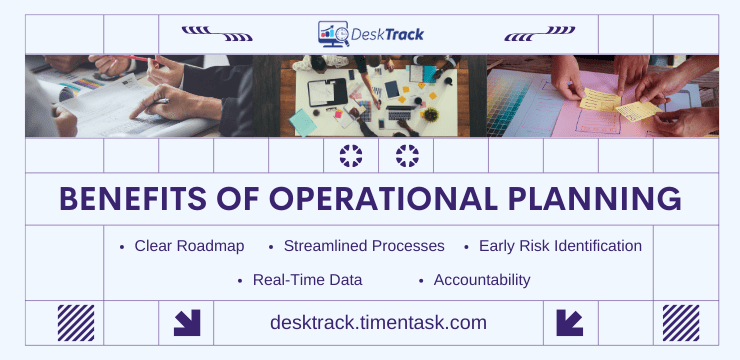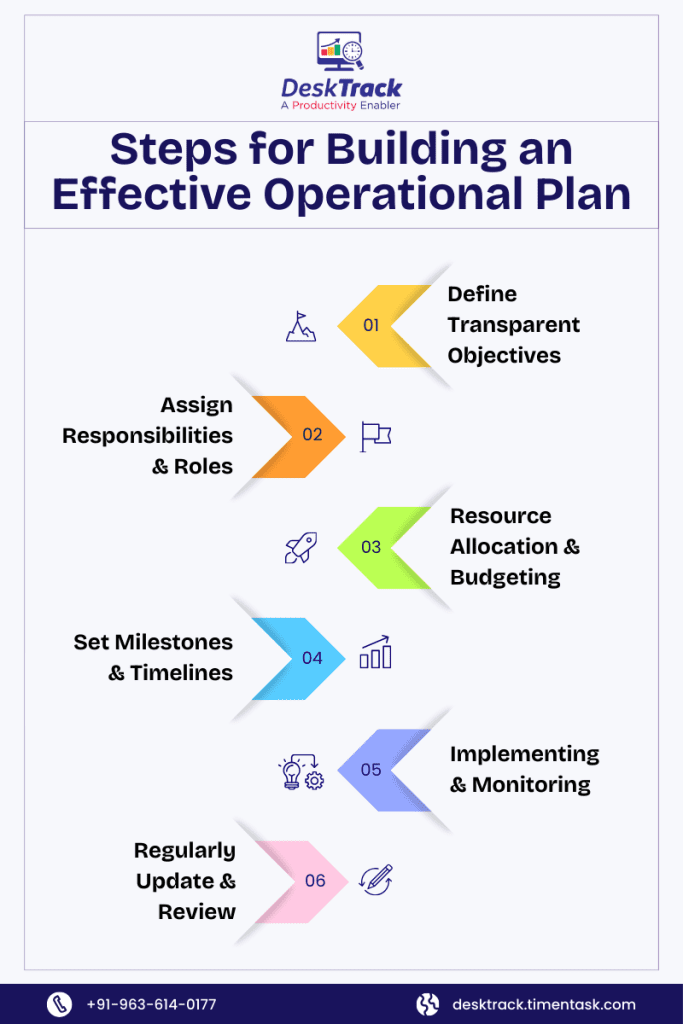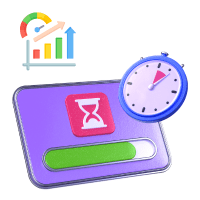Simply put, operational planning connects high-level strategies with daily tasks, making it crucial for achieving all objectives. However, you didn’t understand any of it with this one line. Did you? That’s where we come in with the complete package. In today’s blog post, we will operate on everything involved in creating that one-directional plan.
We will provide you with a definition, key benefits, and tips for efficient operational planning and control. We will provide you with all the detailed and useful insights you need to make a foolproof plan that will lead to the success you desire and deserve. With that, we have a lot to discuss.
What we have for you in store is what operational planning is and how it differs from strategic and tactical planning, its benefits, limitations, the steps and processes you need, and more. So, let’s dive right into making that plan for delivering the best quality project.
What is Operational Planning?
As we mentioned before, operational planning breaks down high-level strategic objectives into a detailed roadmap of tasks that drive your teams’ daily and weekly activities. As an essential part of project management, it breaks down the defined outcomes into manageable tasks, providing your teams with transparent priorities, deadlines, and member-specific milestones:
- Everyone gets an accurate understanding of their priorities and responsibilities.
- This transparency aligns the business and moves toward consistent progress with common objectives.
- It enables your workers to collaborate fluidly, adapt to changes, and work with confidence, consistently leading to strategic goals being achieved.
Benefits of Operational Planning

When your operational planning team achieves success, it is beneficial for your entire organization. Here are the advantages you will experience.
1. Clear Roadmap
The plan provides your teams with a transparent path, bringing the whole team together. Due to these roles, tasks, and timelines, communication pipelines are optimal throughout departments. Plus, team members know what to do, misunderstandings are reduced, and everyone collaborates unitedly.
2. Streamlined Processes
Due to organized workflows, no redundant tasks, and decreased inefficiencies, teams focus on strategic goals, saving hours and eliminating unnecessary steps. It lets your groups concentrate on the highest-impact work.
3. Early Risk Identification
Managers can use an operating plan to uncover potential risks or obstructions before they become major problems. What this does is let your teams take immediate measures, ensuring that projects progress delay-free and optimally. Overall, work stays on schedule as workers stay prepared, handling problems as they arise.
4. Real-Time Data
A well-structured plan arranges data in a simple-to-manipulate way, assisting your laborers in making informed decisions. With real-time progress and resource oversight, making adjustments is quick, which keeps the teams aligned with the collective objectives for responsive and well-informed decision-making.
5. Accountability
Every team member understands their particular contributions. Due to defined expectations, you get a culture of accountability and responsibility. Overall, team members take ownership of their roles, confidently contributing to the whole group.
Limitations of Operational Planning
Make your workday more productive
Time tracking and work management can help you reach your goals
faster.
Like everything else, operational planning also comes with its cons you need to be aware of. Fortunately, this type of plan only comes with 3 of them.
1. Rigidity
Operational plans are rigid, stopping adaptability and responsiveness to unexpected situations or market changes.
2. Resource Constraints
Making and utilizing such a plan consumes a lot of your time and resources.
3. Overemphasis on Details
The overflow of insights in your operational plan can make you go off track from your collective objectives.
Read Also: What is Milestone Trend Analysis?
Who is Responsible for Operational Planning?
Operational planning involves the collective effort of different human resources at various levels of your organization. This forms a hierarchy and interconnectivity of roles and responsibilities at each stage:
- Operations Managers: They are responsible for supervising the plan’s daily elements. They work closely with teams to maintain workflow efficiency and ensure that the resource allocation is good for both immediate and project-wide requirements.
- Department Heads: They align the work of the teams with your business’s objectives. Department heads are responsible for breaking down strategic goals into tasks particular to departments, prioritizing, and coordinating with other departments to maintain overall alignment.
- Project Leads: Project leads have the responsibility to manage particular projects within the plan, task coordination, progress tracking, and maintain team focus on short-term goals that support larger objectives. Furthermore, they also need to update department heads on progress and indicate any adjustments that may be required.
Strategic Planning Vs. Operational Planning
At some stage, strategic planning may seem similar to operational planning. However, there is a huge difference when it comes to the scope, focus, timeframe, and responsibility involved in each of these concepts.
| Key Aspect | Strategic Planning | Operational Planning |
| Focus & Scope | Larger objectives | Daily actions and tasks |
| Timeframe | Several years | Shorter timeframes |
| Responsibility | Executive teams | Department leads |
Elements of an Operational Plan

As an operational planner, understanding these elements involved in the process is crucial:
- Objectives: These set the bar for success with particular and measurable goals that align with your strategic vision. Remember that transparent objectives ensure that the team’s focus is on the right track.
- Vision & Mission Statements: This includes the purpose and long-term aspirations of your business. Vision and mission statements create a shared understanding of what the teams have to work toward.
- KPIs & Goals: Objectives broken down into time-bound tasks. KPIs are used to measure progress and make it simpler to analyze team performance and adjust plans as required.
- Milestones & Timeline: A schedule with completion dates and major milestones, which are for assisting the teams in monitoring the progress and staying on par with crucial deadlines.
- Responsibilities & Roles: Simply put, this is who is doing what and when. What it does is add clarity to each human resource’s contribution, decreases confusion to almost 0, and strengthens accountability across the teams.
- Financial & Resources Summary: This is the number of workers, tools, and money needed to achieve the objectives. A financial summary is the best way to control spending, ensuring that the plan remains sustainable.
- Hiring Plan: A hiring timeline according to your staffing requirements.
- Tactics & Strategies: A detailed layout of the actions and methods that will push your objectives forward. What it does is turn high-level strategies into particular steps for each phase of the project.
- Risks & Key Assumptions: A list of the assumptions that mark any potential challenges based on the risk analysis. This prepares teams to quickly respond in case of any unexpected obstructions.
- Metrics: These are values against which success is measured. Consistently tracking these measurables lets your teams adjust according to current data.
- Next Steps: It’s a blueprint of follow-up actions or adjustments required to maintain a streamlined workflow.
The Process of Operational Planning
Making these directional plans is not a long, drawn-out process as you might think. Not everything has to be complicated. Right? Here’s how operational planning works, and you might want to use the best business management software solution, such as DeskTrack, to make it simpler.
- Stakeholder Alignment: You need to collect input from all the stakeholders early to form a well-rounded plan. When you have multiple points of view, it assists in handling the various requirements and objectives. Overall, it decreases potential obstacles, leading to shared commitment.
- Timeline Planning: A good idea is to make a realistic timeline that arranges each stage of the project, from the first tasks to the last outcomes. It’s also wise to break it down into particular milestones to make progress monitoring and dependency management simple, leading to organized and on-track teams.
- Progress Tracking: You also need systems for progress monitoring and KPI tracking. Doing it consistently keeps your teams accountable and responsible with data on what’s working and where adjustments might be required. Overall, it supports ongoing improvement.
- Regular Adjustments & Reviews: Periodic assessments are necessary due to the fast-paced working atmospheres of today. Regular reviews assist your teams in measuring the current plan, shifting priorities, and improving strategies. Thanks to these updates, your plan stays aligned with business objectives and relevant.
Steps for Building an Effective Operational Plan

As an operational planner, you will need to carefully draft out the directional plan, which the department heads, operations managers, and project leads will carry forward. Here’s what you need to do.
1. Define Transparent Objectives
The first thing, as always, is to define the goals you wish to achieve and have enough clarity in them to ensure that there are no misunderstandings. Overall, you should try to include as much detail and specificity as possible.
2. Assign Responsibilities & Roles
Now every worker must know what to do and at what time. You will let them know by assigning roles and responsibilities. This also makes everyone involved equally accountable and responsible.
3. Resource Allocation & Budgeting
The next step in your operational planning process involves resource allocation and budgeting. You need to distribute and allocate the right human and other resources to the correct tasks. That means that you should have the right person working on the right job at the right time. Yes, everyone gets their rights with a proper budget, which must be maintained at all times.
4. Set Milestones & Timelines
The allocated tasks must also be achievable. In simple words, there must be a timeline. To reach this bar, you need to set milestones, which are savepoints till which a specific part of the project is completed. A collective set of milestones reached provides you with the desired output.
5. Implementing & Monitoring
Once the directional plan has been made, you need to distribute it to the different channels. However, that’s not where the work ends. Monitoring team progress and identifying whether everything is going according to the plan, or not with the right employee management software is also crucial.
6. Regularly Update & Review
Unforeseen circumstances can occur at any time. Thus, you also need to review and update your plan regularly to ensure that it stays flexible enough to adapt to the current workflow.
Read Also: What is Scope Creep in Project Management?
Examples of Operational Planning
The directional plan we are talking about has applications in a multitude of industries. Here are some operational planning examples for a practical understanding.
- Retail: It assists retail teams in monitoring stock levels, coordinating with suppliers, and streamlining storage. A good plan lets teams anticipate demand, preventing both shortages and overstock, ensuring that products are ready where and when consumers need them.
- Healthcare: It supports staff scheduling and resource management, ensuring the delivery of high-quality patient care. It ensures the alignment of staffing with patient demand due to resource adjustment during peak hours. This structure lets healthcare facilities with a budget meet the demands for skilled professionals, supporting uninterrupted service.
- Education: It helps schools organize classes, assign teachers, and distribute resources. A transparent plan here lets schools do schedule coordinating, progress monitoring, and adjust and create a structured atmosphere as the learning requirements of the pupils evolve.
- Marketing: Marketing teams can define objectives, allocate roles, and track progress. This ensures that projects stay on budget and teams achieve desirable results. Plus, it helps teams adapt strategies based on campaign performance, leading to successful, multi-channel ventures.
Strategic Vs. Tactical Vs. Operational Planning
Another kind of planning added to the mix is tactical planning. Combined with strategic and operational planning, it leads your projects on a path to success:
|
Revolves around your business’s overall long-term vision and collective objectives. It frequently oversees years ahead, laying down the groundwork for future development, driving major initiatives, and fixing a direction. |
|
Turns the future-oriented vision into particular short-term steps. The focus is on daily and weekly tasks, moving your business closer to its larger objectives. This is often organized yearly or quarterly to ensure that teams stay aligned with the strategic direction. |
|
Revolves around team-specific actions needed to reach operational goals. It provides your departments and teams with a transparent outline of responsibilities and tasks, closing the distance between high-level organizational goals and daily activities. |
Conclusion
Now, we hope you are clear about strategic planning, its benefits, limitations, and the processes and elements involved. We intended to help you make better plans for your operations, and we hope that the useful insights we provided will indeed benefit your projects in one way or another. With that being said, here’s a final word: project planning and management is one thing. However, that alone cannot lead to success. You need to ensure that your employees are putting in the required effort with or without your presence. With DeskTrack’s real-time employee monitoring features, such as screenshots, time tracking with reports, web, app, and file usage monitoring, and real-time timesheeting, you maintain work integrity, accountability, focus, efficiency, productivity, and skyrocket profitability. Try now and discover why DeskTrack is the first choice across 100+ nations and 8000+ businesses.
Frequently Asked Questions (FAQ)
Q. What is Operational Planning?
Ans. As we mentioned before, operational planning breaks down high-level strategic objectives into a detailed roadmap of tasks that drive your teams’ daily and weekly activities. As an essential part of project management, it breaks down the defined outcomes into manageable tasks, providing your teams with transparent priorities, deadlines, and member-specific milestones.
Q. What are the Elements of an Operational Plan?
Ans. A perfect operational plan includes:
- Objectives
- Vision & Mission Statements
- KPIs & Goals
- Milestones & Timeline
- Responsibilities & Roles
- Financial & Resources Summary
- Hiring Plan
- Tactics & Strategies
- Risks & Key Assumptions
- Metrics
- Next Steps
Q. What are the Benefits of Operational Planning?
Ans. Here’s how operational planning benefits your business.
- Clear Roadmap
- Streamlined Processes
- Early Risk Identification
- Real-Time Data
- Accountability
Q. What are the Limitations of Operational Planning?
Ans. There are a few cons of an operational plan as well.
- Rigidity
- Resource Constraints
- Overemphasis on Details
Q. What are the Steps to Build an Effective Operational Plan?
Ans. You will need these steps.
- Define Transparent Objectives
- Assign Responsibilities & Roles
- Resource Allocation & Budgeting
- Set Milestones & Timelines
- Implementing & Monitoring
- Regularly Update & Review











